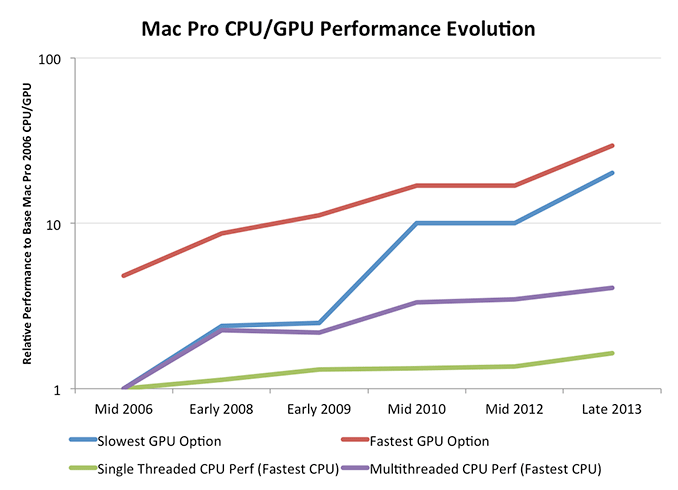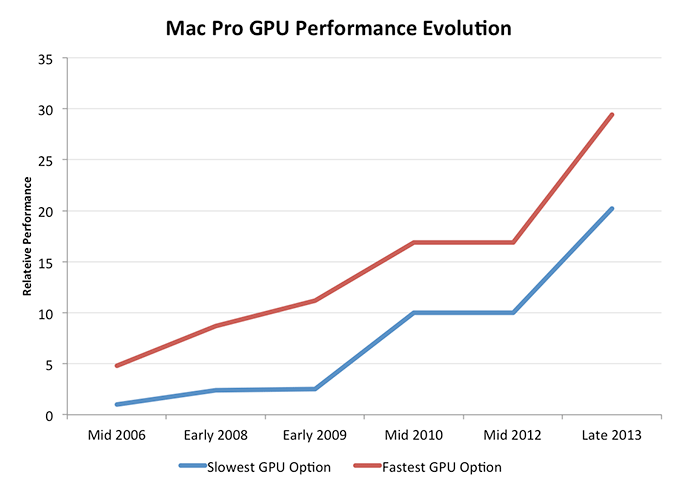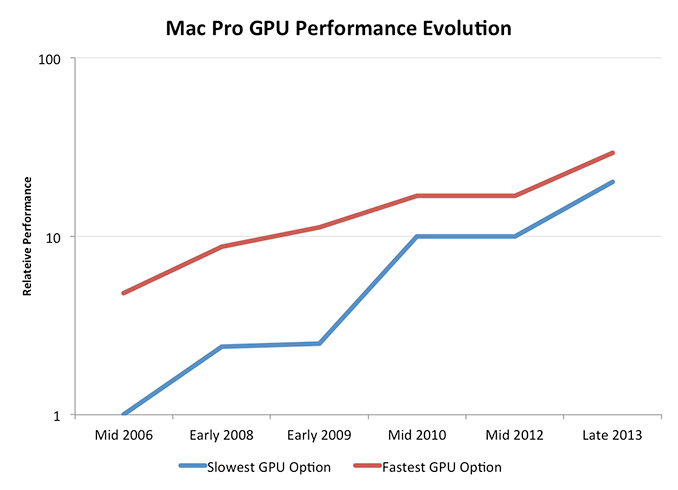The Mac Pro Review (Late 2013)
by Anand Lal Shimpi on December 31, 2013 3:18 PM ESTPlotting the Mac Pro’s GPU Performance Over Time
The Mac Pro’s CPU options have ballooned at times during its 7 year history. What started with four CPU options grew to six for the early 2009 - mid 2010 models. It was also during that time period that we saw an expansion of the number of total core counts from 4 up to the current mix of 4, 6, 8 and 12 core configurations.
What’s particularly unique about this year’s Mac Pro is that all configurations are accomplished with a single socket. Moore’s Law and the process cadence it characterizes leave us in a place where Intel can effectively ship a single die with 12 big x86 cores. It wasn’t that long ago where you’d need multiple sockets to achieve the same thing.
While the CPU moved to a single socket configuration this year, the Mac Pro’s GPU went the opposite direction. For the first time in Mac Pro history, the new system ships with two GPUs in all configurations. I turned to Ryan Smith, our Senior GPU Editor, for his help in roughly characterizing Mac Pro GPU options over the years.
| Mac Pro - GPU Upgrade Path | ||||||||||
| Mid 2006 | Early 2008 | Early 2009 | Mid 2010 | Mid 2012 | Late 2013 | |||||
| Slowest GPU Option | NVIDIA GeForce 7300 GT | ATI Radeon HD 2600 XT | NVIDIA GeForce GT 120 | ATI Radeon HD 5770 | ATI Radeon HD 5770 | Dual AMD FirePro D300 | ||||
| Fastest GPU Option | NVIDIA Quadro FX 4500 | NVIDIA Quadro FX 5600 | ATI Radeon HD 4870 | ATI Radeon HD 5870 | ATI Radeon HD 5870 | Dual AMD FirePro D700 | ||||
Since the Mac Pro GPU offerings were limited to 2 - 3 cards per generation, it was pretty easy to put together comparisons. We eliminated the mid range configuration for this comparison and only looked at scaling with the cheapest and most expensive GPU options each generation.
Now we’re talking. At the low end, Mac Pro GPU performance improved by 20x over the past 7 years. Even if you always bought the fastest GPU possible you'd be looking at a 6x increase in performance, and that's not taking into account the move to multiple GPUs this last round (if you assume 50% multi-GPU scaling then even the high end path would net you 9x better GPU performance over 7 years).
Ryan recommended presenting the data with a log scale as well to more accurately depict the gains over time:
Here you see convergence, at a high level, between the slowest and fastest GPU options in the Mac Pro. Another way of putting it is that Apple values GPU performance more today than it did back in 2006, so even the cheapest GPU is a much higher performing part than it would be.
If you’re a GPU company (or a Senior GPU Editor), this next chart should make you very happy. Here I’m comparing relative increases in performance for both CPU and GPU on the same graph:
This is exactly why Apple (and AMD) is so fond of ramping up GPU performance: it’s the only way to get serious performance gains each generation. Ultimately we’ll see GPU performance gains level off as well, but if you want to scale compute in a serious way you need to heavily leverage faster GPUs.
This is the crux of the Mac Pro story. It’s not just about a faster CPU, but rather a true shift towards GPU compute. In a little over a year, Apple increased the GPU horsepower of the cheapest Mac Pro by as great of a margin as it did from 2006 - 2012. The fastest GPU option didn’t improve by quite as much, but it’s close.

Looking at the same data on a log scale you’ll see that the percentage increase in GPU performance is slowing down over time, much like what we saw with CPUs, just to a much lesser extent. Note that this graph doesn't take into account that the Late 2013 Mac Pro has a second GPU. If we take that into account, GPU performance scaling obviously looks even better. Scaling silicon performance is tough regardless of what space you’re playing in these days. If you’re looking for big performance gains though, you’ll need to exploit the GPU.
The similarities between what I’m saying here about GPU performance and AMD’s mantra over the past few years aren’t lost. The key difference between Apple’s approach and those of every other GPU company is that Apple spends handsomely to ensure it has close to the best single threaded CPU performance as well as the best GPU performance. This is an important distinction, and ultimately the right approach.













267 Comments
View All Comments
zephonic - Tuesday, December 31, 2013 - link
Thanks for the first thorough review of the MacPro, and on the last day of 2013!Happy New Year!
solipsism - Tuesday, December 31, 2013 - link
I'm surprised that you can't have 3x4K displays all off the TB ports since the one HDMI port is connected to TB Bus 0.lilo777 - Tuesday, December 31, 2013 - link
The review is very disappointing. Normally workstation review would contain performance comparisons with other workstations not with all-in-one consumer computers equipped with mobile parts. How about comparing MP with real workstations? Perhaps that would put its size shrink into proper perspective.darkcrayon - Wednesday, January 1, 2014 - link
From the review, there's no reason to believe the Windows performance would be much different from other similarly configured workstations (which we know are of similar cost), with similar CPUs and GPUs. And of course if you need to work in Final Cut Pro, there wouldn't be an exact comparison available anyway.hoboville - Thursday, January 2, 2014 - link
"No reason to believe performance would be different".Interesting to hear you say that, as these GPUs are underclocked to meet the thermal headroom. For raw performance metrics, the gaming shows how CFX D700 compares to its consumer twin the 7970 GHz / R9 280X, it's slower. More RAM, sure, but it's not ECC which is what real workstations use. And if you're not using more than 3 GB...you're wasting money.
This is a Final Cut Pro computer or a computer for those who only use Mac software. Too bad for them, as they have to pay more for less power.
akdj - Wednesday, January 1, 2014 - link
Did you read page one? There really isn't anything to 'compare' it TOO! No one else is offering different chipsets in their workstations. PCIe SSDs are rare and thunderbolt is all but non existent so far in Windows landwiz329 - Tuesday, December 31, 2013 - link
@Ananad, does the fact that there are only 8 PCIe lanes available to the IO mean that we could see some bottlenecks if there are a large number of external devices attached/in use?wiz329 - Tuesday, December 31, 2013 - link
*Anandtipoo - Tuesday, December 31, 2013 - link
So you can't get the cards to be Firepros under Windows? I suspected something like that would be the case with the cost of actual firepros, since apple writes much of the graphics driver there's less of a difference in osx, while they seem like bog standard radeons with somewhat odd configs in Windows. That may take some value away for pros who work with high end apps in both.tipoo - Wednesday, January 1, 2014 - link
There were also reports of 7900 series Radeons showing up as D*** series FirePros in OSX. It appears Apple is just eliminating the distinction between them, just calling standard Radeons FirePros.